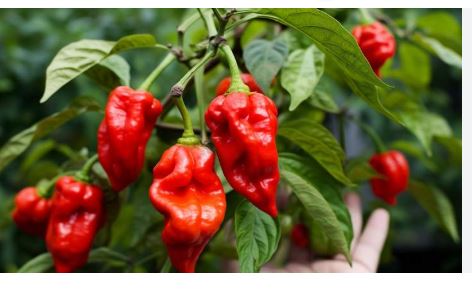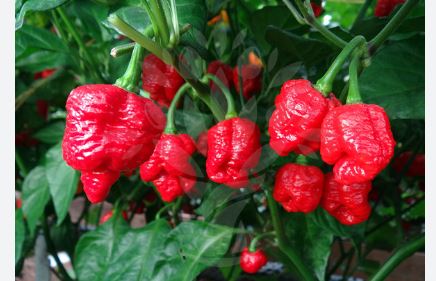
The Trinidad Moruga Scorpion belongs to the genus Capsicum and the species Capsicum chinense, a group renowned for producing some of the hottest peppers, including habaneros, Scotch Bonnets, and the Carolina Reaper. The Capsicum genus, part of the Solanaceae (nightshade) family, encompasses over 30 species, but C. chinense is distinguished by its wrinkled, pungent fruits and high capsaicin content. The Moruga Scorpion is a naturally occurring cultivar, not a hybrid like the Carolina Reaper, though its exact lineage is unclear, likely descending from local Trinidadian C. chinense varieties. Its capsaicinoids, concentrated in the placenta and locules, contribute to its extreme heat, aligning it with other super-hot chilies in the species.
The Trinidad Moruga Scorpion hails from the Moruga district in southern Trinidad and Tobago, a region known for its rich chili-growing tradition. Unlike many modern super-hot peppers bred through selective hybridization, the Moruga Scorpion is a landrace variety, cultivated for generations by local farmers before gaining global recognition. Its heat and flavor were formally tested in 2012 by New Mexico State University’s Chile Pepper Institute, which confirmed its average of 1.2 million SHU, with peaks up to 2 million SHU, earning it the Guinness World Record as the hottest pepper at the time. The pepper’s cultural significance in Trinidad, where fiery foods are a culinary cornerstone, has made it a symbol of Caribbean spice heritage, now grown worldwide by chili enthusiasts.
The Trinidad Moruga Scorpion is ferociously hot, averaging 1.2 million SHU, with individual peppers reaching up to 2 million SHU, as verified by HPLC testing. This places it far above a habanero (100,000–350,000 SHU) and roughly 800 times hotter than a jalapeño (2,500 SHU), though slightly below the Carolina Reaper’s peak of 2.2 million SHU. Its capsaicinoids deliver a sharp, immediate burn that intensifies over 10–20 seconds, causing severe mouth and throat discomfort, sweating, and potential nausea or cramping. The heat can linger for 30–60 minutes, making it a staple in extreme chili challenges. Handling requires gloves and eye protection to avoid capsaicin burns, as even skin contact can cause irritation.

Despite its punishing heat, the Trinidad Moruga Scorpion offers a complex and appealing flavor profile, a hallmark of Capsicum chinense peppers. The initial taste is sweet and fruity, with notes of tropical fruit, citrus, and a subtle floral undertone, often likened to mango or pineapple. This sweetness is quickly overwhelmed by an intense, searing heat that dominates the experience. The pepper’s appearance is striking, with small, wrinkled, golf-ball-sized pods (1–2 inches in diameter) that ripen from green to yellow, orange, and finally bright red. Its bumpy, scorpion-tailed surface, reminiscent of a scorpion’s stinger, gives it its name. The plants are bushy, growing 2–4 feet tall, and highly productive, yielding dozens of pods in optimal tropical conditions.
The Trinidad Moruga Scorpion’s extreme heat limits its use in everyday cooking, but it shines in specialized culinary applications. It is a key ingredient in ultra-hot sauces, such as those from Trinidadian brands or global producers like CaJohns Fiery Foods, where its fruity notes complement the fiery kick. In Caribbean cuisine, it’s used sparingly in pepper sauces, jerk seasonings, and stews, often diluted with milder ingredients to make its heat manageable. The pepper is also popular in competitive eating challenges and chili festivals, where its reputation draws thrill-seekers. In small doses, it enhances salsas, chili powders, and spice blends, but requires careful handling to avoid overpowering dishes. Beyond food, its capsaicin is explored for pain relief creams and anti-inflammatory treatments, though such uses are niche and require professional processing. Always consume with caution, paired with dairy (milk, yogurt) to mitigate the burn.
The Trinidad Moruga Scorpion’s rise to fame has made it widely accessible, with seeds, plants, and dried or fresh pods available from numerous vendors, unlike the proprietary Pepper X. Its cultivation has spread globally, from home gardens to commercial farms, fueled by its reputation and cultural significance. However, its extreme heat poses risks: overconsumption can cause severe digestive distress, and rare cases have led to medical emergencies like esophageal irritation. The pepper’s popularity on social media, with viral videos of people attempting to eat it raw, has cemented its status as a cultural phenomenon, embodying the allure and danger of super-hot chilies.

Cultivation of Trinidad Moruga Scorpion Peppers
1. Climate and Temperature
Trinidad Moruga Scorpion thrives in hot, humid tropical climates, reflecting its Caribbean origins. Ideal daytime temperatures range from 75–85°F (24–29°C), with nighttime lows above 60°F (15°C). Cold below 54°F (12°C) stunts growth, while prolonged heat above 95°F (35°C) can reduce fruit set. In temperate regions, use greenhouses, high tunnels, or indoor setups with grow lights to maintain warmth during the 90–120-day growing season, ensuring consistent heat to boost capsaicin production.
2. Soil Requirements
Grow Moruga Scorpion in well-drained, loamy soil with a pH of 5.5–6.5, slightly acidic to optimize nutrient uptake. Add organic matter like compost or aged manure to enhance fertility and water retention. Avoid heavy clay soils, as C. chinense roots are shallow and prone to rot in waterlogged conditions. Conduct a soil test to balance phosphorus and potassium levels, as excess nitrogen can prioritize leafy growth over fruit, potentially reducing heat intensity.
3. Seed Starting
Start seeds indoors 8–12 weeks before the last frost, as C. chinense seeds germinate slowly (14–28 days). Use a sterile seed-starting mix and maintain soil temperatures of 80–90°F (27–32°C) with a heat mat for optimal germination. Provide 16 hours of bright light daily using LED or fluorescent grow lights to prevent leggy seedlings. Keep soil moist but not soggy, using a humidity dome to retain moisture. Seeds are widely available from reputable vendors, making this pepper accessible to growers.
4. Transplanting
Transplant seedlings outdoors or into a greenhouse when soil temperatures reach at least 65°F (18°C) and nighttime lows stay above 60°F (15°C). Space plants 18–24 inches apart in rows 24–36 inches apart to accommodate their bushy, 2–4-foot-tall growth. Select a site with full sun (6–8 hours daily), as sunlight enhances capsaicin production. Harden off seedlings over 7–10 days to acclimate them to outdoor conditions, minimizing transplant shock.
5. Watering
Provide consistent, deep watering to keep soil moist but not waterlogged, as Moruga Scorpion is sensitive to drought and overwatering. Water 1–2 times weekly, delivering 1–2 inches of water, adjusted for soil type and climate. Sandy soils may require more frequent watering. Use drip irrigation or soaker hoses to keep foliage dry, reducing fungal disease risk. Inconsistent moisture can cause blossom-end rot or cracked fruits, so monitor soil closely during flowering and fruiting.
6. Fertilization
Apply a balanced fertilizer (e.g., 10-10-10) at planting to establish roots, then switch to a low-nitrogen, high-potassium formula (e.g., 5-10-15) during flowering and fruiting to promote pod development and capsaicin levels. Fertilize every 2–3 weeks, guided by soil tests to avoid over-feeding, which can dilute heat. Organic options like fish emulsion, seaweed extract, or compost tea support healthy growth. Limit nitrogen to prevent excessive foliage at the expense of fruit.
7. Mulching
Apply a 2–4-inch layer of organic mulch, such as straw, wood chips, or herbicide-free grass clippings, to conserve moisture, suppress weeds, and regulate soil temperature. Black plastic mulch is effective for warming soil in cooler climates, increasing yields by maintaining root zone heat, critical for C. chinense. Mulching also prevents soil splash onto leaves, reducing soil-borne diseases like bacterial leaf spot, which can affect Moruga Scorpion.
8. Plant Density
Optimize plant density to balance yield and pungency, as C. chinense studies suggest spacing impacts fruit production. A density of 15,000–18,000 plants per hectare (6,000–7,300 per acre) can maximize fruit number and capsaicin content per area, while lower densities (10,000–12,000 per hectare) may increase individual plant yields. In home gardens, maintain 18–24-inch spacing to ensure airflow and light penetration, supporting healthy fruit set and disease prevention.
9. Pest and Disease Management
Moruga Scorpion is susceptible to pests like aphids, spider mites, and whiteflies, and diseases such as bacterial leaf spot, anthracnose, and viral infections (e.g., Tobacco Mosaic Virus). Use integrated pest management (IPM) with neem oil, insecticidal soap, or beneficial insects like ladybugs. Monitor for leaf curl or mosaic patterns, indicating viral issues, and remove affected plants. Ensure good air circulation, avoid overhead watering, and rotate crops every 2–3 years to minimize soil-borne pathogens.
10. Pollination
Moruga Scorpion is self-pollinating, with small, white, five-petaled flowers that set fruit without external pollinators. Gentle shaking of plants or introducing bees can improve fruit set, especially in greenhouses or low-pollinator areas. High temperatures (above 90°F/32°C) can reduce pollen viability, so use shade cloth or misting during heatwaves. Each node typically produces 2–4 fruits, and consistent pollination ensures the characteristic wrinkled, scorpion-tailed pods.
11. Pruning and Support
Lightly prune Moruga Scorpion plants to remove suckers, dead leaves, or lower foliage touching the soil, improving airflow and reducing disease risk. Avoid heavy pruning, as it can stress C. chinense and lower yields. Use stakes, cages, or trellises to support bushy plants, especially during fruiting, as heavy pod loads can snap branches. Support is crucial for the Scorpion’s prolific yields, which can produce dozens of pods per plant.
12. Harvesting
Harvest pods when they ripen from green to yellow, orange, and finally bright red, typically 90–120 days after transplanting, for maximum heat and flavor. Mature pods are wrinkled, golf-ball-sized, with a scorpion-like tail. Use gloves and scissors to cut pods, avoiding skin contact with capsaicin-rich tissues, which can cause burns. Regular harvesting encourages further fruit production. Pods can be used fresh, dried, or powdered, but handle with extreme care due to their 1.2–2 million SHU potency.
13. Challenges and Considerations
Cultivating Trinidad Moruga Scorpion is challenging due to its long growing season, sensitivity to temperature extremes, and vulnerability to pests and diseases. Its extreme heat requires protective gear during handling, as capsaicin can irritate skin, eyes, and respiratory systems. Inconsistent watering or nutrient imbalances can reduce capsaicinoid content, diluting its signature heat. Growers in cooler climates may need row covers, heated greenhouses, or season-extension techniques. Despite these challenges, its wide availability as seeds and plants makes it accessible, rewarding dedicated growers with high yields and unmatched pungency.